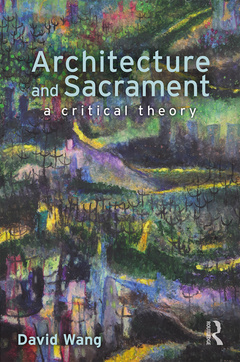Architecture and Sacrament A Critical Theory
Auteur : Wang David

David Wang?s Architecture and Sacrament considers architectural theory from a Christian theological perspective, specifically, the analogy of being (analogia entis). The book tracks social and cultural reasons why the theological literature tends to be separate from contemporary architecture theory. Wang argues that retrieval of the sacramental outlook embedded within the analogy of being, which informed centuries of art and architecture in the West, can shed light on current architectural issues such as "big box stores," the environmental crisis and the loss of sense of community. The book critiques the materialist basis of current architectural discourse, subsumed largely under the banner of critical theory. This volume on how European ideas inform architectural theory complements Wang?s previous book, A Philosophy of Chinese Architecture: Past, Present, Future, and will appeal to architecture students and academics, as well as those grappling with the philosophical moorings of all built environments.
Introduction 1. Architecture in a world of originals 2. The loss of glow: architecture in an age of representation 3. A critique of "criticalist" architectural theory 4. Dwelling in the sacramental zone 5. Sustainable design in the sacramental zone 6. Creativity in the sacramental zone 7. God in the details: sacrament and tectonic jointure Bibliography Index
David Wang is Professor Emeritus of Architecture at Washington State University. His previous book is A Philosophy of Chinese Architecture Past, Present, Future (Routledge). Dr. Wang has written and lectured widely on design research. His co-authored text Architectural Research Methods (with Linda Groat) is in its second edition. He is also co-editor (with Dana Vaux) of Research Methods for Interior Design: Applying Interiority (Routledge).
Date de parution : 04-2020
15.2x22.9 cm
Date de parution : 04-2020
15.2x22.9 cm
Thèmes d’Architecture and Sacrament :
Mots-clés :
Analogia Entis; Christian; Good Life; Christianity; English Langue; aesthetics; Chicago Stock Exchange; theology; Erich Przywara; religion; Sacramental Experience; philosophy; Sacramental Participation; Balthasar; Hut Theories; metaphysics; Artificial Life Form; modernism; Building Dwelling Thinking; post modernism; Zhu Xi; Wittgenstein; Occupy Wall Street; Venturi; Great Ultimate; Lyotard; Barth’s Concerns; authenticity; Sustainable Design; Walter Benjamin; Incarnational Life; representation; Crab Shell; mechanical reproduction; Transcendental Structure; critical theory; Bullitt Center; genius loci; Swat; Christian Norberg-Shulz; God’s Essence; phenomenology; Inductive Prediction; Jewish Museum; Immanent Loop; Forbidden City



